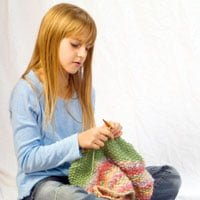60-day returns • free shipping on USA orders $129+


“What’s the point?”
I often ask myself that question, especially when it comes to various demands on my time. If someone tells me I should add a certain activity to my already-full schedule, I want to know why. Tell me what that activity will gain for me.
For many moms, handicrafts fall under the “What’s the point?” heading. Yes, Charlotte Mason included handicrafts in her curriculum. But why? What are the reasons behind it? What will it gain for my child and me?
It’s easy to view handicrafts as just a nice little busywork option unless we understand what Charlotte was trying to accomplish with this integral part of her school week.
Benefits of Handicrafts
- Train the eye and hand.
Handicrafts help train the eye and the hand. You remember that Charlotte emphasized the habit of observation, looking closely and carefully at something. Handicrafts provide lots of opportunities to observe; and the more often your child observes, the sooner that skill will become a helpful habit.
Handicrafts also provide lots of practice in eye-hand coordination. Training your hand to work in tandem with your eye requires time and experience. Handicrafts offer a wonderful arena in which to develop that skill.
- Cultivate the artistic feeling.
Charlotte emphasized filling the mind and heart with beautiful and worthy images. She rejected anything vulgar. We often think of those principles when doing picture study. But those principles also carry over to handicrafts. Charlotte chose handicrafts, and specific projects within those handicrafts, to help cultivate the child’s sense of and appreciation for beauty. We can do the same.
- Train in neatness, or good taste.
Handicrafts also provide a great opportunity to train the senses toward good taste. That’s what Charlotte meant by “neatness.” In her words, “Neatness is akin to order, but is not quite the same thing: it implies not only ‘a place for everything, and everything in its place,’ but everything in a suitable place, so as to produce a good effect; in fact, taste comes into play. The little girl must not only put her flowers in water, but arrange them prettily, and must not be put off with some rude kitchen mug or jug for them, or some hideous pink vase, but must have jar or vase graceful in form and harmonious in hue, though it be but a cheap trifle” (Vol. 1, pp. 130, 131).
- Train in manual dexterity.
There is a lot to be said for muscle memory. The more the hand muscles repeat a motion, the more you can fine tune that motion for precision. No matter which handicraft you select, it will provide excellent training ground for manual dexterity.
- Establish due relations with various materials.
Maybe you’ve read about throwing clay pots on a wheel. Maybe you’ve even seen a demonstration. But have you ever tried it yourself — gotten your hands messy and felt the clay turning on the wheel under your hands? When you experience something for yourself — when it touches your imagination and emotions — that’s when you really know it. Remember, Charlotte believed that education is the science of forming personal relations with people and things. Handicrafts provide natural opportunities for that type of education.
“He practises various handicrafts that he may know the feel of wood, clay, leather, and the joy of handling tools, that is, that he may establish a due relation with materials” (Vol. 6, p. 31).
- Experience the pleasure of exact movements and the triumph of success.
If you are careful in teaching your child what he is to do and selecting handicrafts that will challenge, but not frustrate, your child will taste pleasure and success as he develops his skill.
“The human hand is a wonderful and exquisite instrument to be used in a hundred movements exacting delicacy, direction and force; every such movement is a cause of joy as it leads to the pleasure of execution and the triumph of success. We begin to understand this and make some efforts to train the young in the deft handling of tools and the practice of handicrafts” (Vol. 6, p. 328).
- Encourage productivity.
Many of the “What’s the point?” reasons behind Charlotte’s habits and methods center around the importance of being of service to others. And handicrafts are no exception. Charlotte wanted to encourage her students to be producers, not just consumers — to be of benefit to others by producing good and beautiful work.
“Some day, perhaps, we shall see apprenticeship to trades revived, and good and beautiful work enforced. In so far, we are laying ourselves out to secure that each shall ‘live his life’; and that, not at his neighbour’s expense; because, so wonderful is the economy of the world that when a man really lives his life he benefits his neighbour as well as himself; we all thrive in the well-being of each” (Vol. 6, p. 328).
So the next time you’re tempted to shelve the handicrafts (again), remember all that Charlotte was trying to accomplish with this weekly activity. Hopefully, reading through that list will give you a gentle nudge toward starting a craft of some kind.
Maybe you want to get started but have no idea where to begin. Not to worry. Next week we’ll discuss ideas for crafts and practical how-to’s for getting started.

Waiting eagerly for Part Two!!
Excellent! My daughter is proof positive to all of this! Since we started homeschooling she has been doing handicrafts and everything you have said is dead on! Thank you!